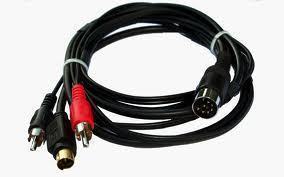S-Video
S-Video is an abbreviation for Separate Video and is also known as the Y/C. it is an analogue video signal that carries the video data as two separate signals; these signals are luma (brightness) and chroma (color). The S-Video can be thus contrasted with composite video, which carries picture information as a single component, albeit of a poor quality. Another signal is called component video and this one carries picture components in three separate signals, one luma and two chroma components. Basically, S-video is used to transmitting a television signal from a device such as the camcorder or a game console and by separating the color information from the brightness, it prevents occurrences such as color bleeding or dot crawl, and this helps to increase clarity and sharpness. Compared to composite signal, S-Video images are almost as twice as sharp, and the color definition is superior. Because of these qualities, the image looks “cleaner”. The transmission of the luma and chroma information on different signals does away with the requirement of using low pass filtering. The process increases the bandwidth of the luma data, thus reducing the problem associated with color crosstalk. As a result, much of the data from the original video signal is left undisturbed. As it is commonly implemented, S-Video carries 480i or 576i resolution video but does not carry audio on the same cable.
Considering S-Video’s basic technique of separating the video and color component, it’s sometimes regarded as a different type of the component video signal. But in S-Video, the color information is transmitted as a different signal altogether. And what this means is that the colors have to be encoded and thus the devices in the implementation of this process need to be compatible with the S-Video as well as the color coding compliant.
So why does the S-Video look better than, say composite signal? This can be explained by going back to basics. A television set needs a signal in the form of brightness and color to display a picture. Secondly, to obtain the best quality of audio or video, its important to keep coding/encoding to a minimum and retain the original signal as much as possible without modification. For instance, the PSX may work with RGB, and its also true that TVs don’t accept an RGB signal (with some exceptions). Thus some encoding is necessary to display those images to the TV. When one uses a composite hookup, the PSX has to encode the RBG image into one signal, which is then sent to the TV. A device called COMB FILTER in the TV separates the composite signals into Chroma and Luma. This separation and encoding disturbs the original format, and therefore, there is a major loss of reproduction quality involved.
On the other hand, when one is using S-Video hookup, the PSX has to encode the RGB image into the two signals, Chroma and Luma. That is what the TV will require, and so it will take what the PSX gives it and displays it since the information is already in the right format. But since there was some encoding involved (RGB to y/c) there is a small loss of reproduction quality.


Comments - No Responses to “S-Video”
Sorry but comments are closed at this time.